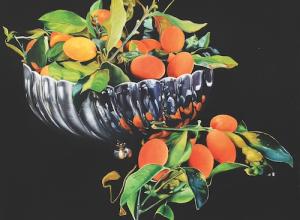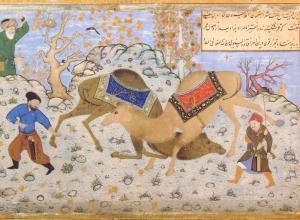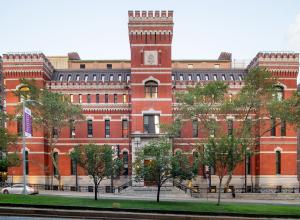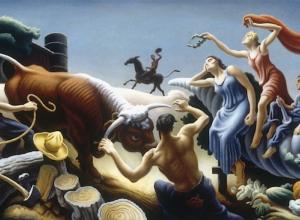
Frieze Los Angeles 2025.
Less than two months after the fatal wildfires devastated Los Angeles, wiping out lives, homes, and property, 97 of the leading global and local galleries united to support LA’s art community at Frieze Los Angeles 2025.
Billed as “A Celebration of Creative Resilience and Community Rebuilding,” the sixth edition of the international art fair opened on February 20th at the Santa Monica Airport with expanded public programming and new initiatives to directly engage with artists and communities affected by the recent challenges. The fair closed on February 23rd with reports of strong sales, a lively atmosphere, and a sense of success in rallying community support.
“Frieze Los Angeles was a resounding success,” said Christine Messineo, Director of Americas, Frieze. “Collectors and institutions engaged with real intent, purchasing with sustained interest throughout the fair, from the opening moments to the final hours on Sunday afternoon. The market has proven its resilience. In the face of recent challenges, the global art community has recognized the vital role of investing in the creative economy. We are deeply grateful to everyone who joined us in this important work, and we look forward to building on the achievements of this year’s edition.”
After evaluating hundreds of works across various media, here are our favorite artists and artworks from Frieze Los Angeles 2025.

One of the most experimental artists of our time, Diana Al-Hadid is known for her panel paintings, sculptures, and architectural structures that seem to dissolve in space. Working with common construction materials, she intuitively builds her handmade pieces drip by drip until her vision is firm.
Fabricating her interlacing compositions in such diverse materials as polymer gypsum, fiberglass, steel, plaster, metal leaf, and pigment, she creates allegorical works representing the passage of time and the ensuing erosion of civilizations.
Exhibiting new panel paintings and a sculpture in her solo presentation at Kasmin’s booth, Al-Hadid mixed scenes from art historical sources related to her Syrian birthplace with views of the changing seasons outside her current Upstate New York home.
Image: Diana Al-Hadid, It's Been Almost a Year, 2024-2025. Polymer gypsum, fiberglass, steel, plaster, metal leaf and pigment, 57.99" x 64.02" (147.3 cm x 162.6 cm).

Expanding the notion of landscape beyond the canvas, artist Sam Falls is not merely inspired by nature, but works directly with its elements. Devising processes that uptake the imprints of all atmospheric conditions—from sunlight to heavy rain, winds, and morning dew—Falls conceives abstract paintings, prints, and ceramics that conceal traces of plant life and memories of place.
His “California Coastal Climates” solo show at the gallery’s booth displayed a new series of paintings and ceramics created with seaweed and aquatic vegetation collected from the Pacific Ocean. Embedding plants into clay, he makes fossilized images, which he then glazes to create his ceramics.
For his paintings, however, he places the plants on canvas and sprinkles them with dry pigments before exposing them to the elements of nature, causing the pigments to define the plants as the colors are intriguingly fixed on the canvas.
Image: Sam Falls, Montana de Oro, 2025. Pigment on canvas, 60" x 48" (152.4 cm x 121.91 cm).

Proyectos Monclova presented a solo booth of Mexican artist Víctor Hugo Pérez’s recent paintings with hand-carved frames of women and animals confronting one another in equally fierce ways, and ceramic figures and vessels illustrating the same type of wild beasts.
In one of the paintings, an Eve-like nude shouts down a dragon desiring her apples in a Garden of Eden setting, while the artist’s sculptural pieces draw more from Mexican folklore than biblical tales.
Employing old artisanal techniques, Pérez used a tool to incise decorative patterns into the glaze on his burnished clay figures of life-size dogs and used the same method to draw cats and dogs on his beautifully crafted, traditionally shaped vessels.
Image: Víctor Hugo Pérez, Gatos del Salto, 2024. Burnished and sgraffito clay, 25.2 x 15.35 x 15.35 in 64 x 39 x 39 cm.

A Yale MFA graduate with a cinematic point of view, Kate Meissner filters the psychological tension of seasoned directors like David Cronenberg, David Lynch, and Todd Haynes through her staged architectural tableaux, which are then transformed into hyperrealistic paintings that astonishingly transcend most movie scenes.
From small-scale models with figurines and montages of digitally collaged body parts, to life-size sets where she uses her own body to act out her surreal scenes, her faceless femme fatales are truncated, draped in latex, and forced into confined spaces to illustrate the nightmarish reality of commodified doll part lives.
Her haunting solo booth presentation in the Focus section of the fair featured seven new acidic-colored paintings of objectified physiques on display, which seems like the perfect response to the age of self-indulgence that’s ubiquitous on social media.
Image: Kate Meissner, Prism, 2025. Oil on canvas, 67.99" x 62.99" (172.7 cm x 160 cm).

An artist and musician of Peruvian and Irish-American descent, Eamon Ore-Giron draws from Andean folklore for the large-scale paintings and ceramic tile pieces from his Talking Shit series in his one-person booth exhibition.
Referencing deities from ancient Peruvian and Mexican cultures, the artist brings his cultural past into present times with a modernist form of abstraction married to pre-Columbian Mesoamerican motifs.
In his persuasive 2024 painting Talking Shit with Viracocha's Rainbow (variation III), Ore-Giron reimagines the creator god of the Andean world as a two-headed serpent in a cosmic realm, strikingly conceived as a colorful wall-work in ceramic tile. The Tucson-born, Los Angeles-based artist sees the graphically composed series as a distinctive way of bringing sacred symbology to life.
Image: Eamon Ore-Giron, Talking Shit with Viracocha's Rainbow (variation III), 2024. Ceramic tile, 72 x 72 in. (182.9 x 182.9 cm).

A non-binary artist of Southeast Asian descent, Maia Cruz Palileo became interested in mining their family history after recreating their immigrant grandparents’ living room for an art installation during college.
Digging deeper into their ancestors’ photo albums and researching cultural archives documenting their Filipino heritage, they uncovered the colonial history between the U.S. and the Philippines, which they found unsettling. Constructing their visual tales similar to how oral histories are passed down, they reclaim their subjects from their colonialist pasts and reanimate them with new stories.
Visiting the Philippines in 2024, they were able to experience places previously encountered through storytelling and documentation, leading to the paintings and sculptures on view in their solo booth show, part of a larger body of work that will appear in Palileo’s first solo exhibition with the gallery in mid-March.
Image: Maia Cruz Palileo, Listening To Water, 2024. Oil on linen, 34.02" x 30" x 1.26" (86.4 cm x 76.2 cm x 3.2 cm).

Widely praised for her uncanny photographic self-portraits appropriating the guise of relatives or famous people, which she calls her spiritual family, Gillian Wearing displayed an artistic bag of tricks in her critically acclaimed Guggenheim Museum retrospective in 2021.
It was the first time many viewers saw the 1997 Turner Prize-winning artist’s watercolors and paintings, which she began making during the Covid-19 lockdown. Whereas those initial works—her first attempt at painting since leaving college—were straightforward self-portraits, her deeper pursuit found her painting herself into the realms of past artists she admired.
Not leaving photography behind, she created a 2023 self-portrait of Artemisia Gentileschi, an Italian Baroque painter who died in Naples in 1653. When invited to exhibit in Napoli the following year, she added new portraits inhabiting the likenesses of contemporary Italian film icons Anna Magnani, Federico Fellini, Pier Paolo Pasolini, and Monica Vitti, which her Los Angeles gallery exhibited at the fair.
Image: Gillian Wearing, Me as Monica Vitti in a wig, 2024. Framed bromide print, 60" x 45" (152.4 cm x 114.3 cm).

Interested in the lifestyles, spiritual practices, and materials related to cultural rituals by people worldwide, Tamara Gonzales collects things during her travels to incorporate into her art when back at her studios in Brooklyn and Upstate New York.
Mining popular culture and mythology for inspiration, she makes paintings, drawings, tapestries, and mosaics exploring Indigenous cultures in the Americas and spiritual and ritual practices from the Far East.
When painting her symbolic images with patterned motifs and simulated frames, she often flips the canvas around so that the compositions can be viewed from any angle.
More recently, she expanded her work to include complex mosaics created from her drawings by craftsmen in Cyprus, which she presented in her solo show for the gallery’s booth, alongside new tapestries inspired by patterns of the Shipibo people of the Amazon and woven by local artisans in Peru.
Image: Tamara Gonzales, Limassol Mosaic No. 5, 2025. Glass mosaic tile mounted on aluminum honeycomb board with maple frame, 48 x 36 in., 121.92 x 91.44 cm, 48.75 x 36.75 in (framed) 123.83 x 93.34 cm (framed).

Constructing lusciously detailed paintings that reflect a global, intercultural community of nomadic people–of which he is a part—Tomokazu Matsuyama draws upon the consumerist nature and celebrity focus of American Pop Art mingled with European art historical influences and the more decorative Edo period aesthetics of his native Japan.
Having immigrated from Japan to California as a child, the New York-based artist viewed his solo booth at the fair as a homecoming by planning additional projects around Los Angeles— including a massive public mural in Melrose Hill and digital works on the façade of the historic Grauman’s Chinese Theatre in Hollywood.
In the fair booth, Matsuyama exhibited nine large-scale shaped paintings on a lively array of colored-coordinated walls. Created from digital collages of imagery reflecting his multicultural influences, the animated canvases convey dreamlike settings where life is blissful and each day sparkles with enchantment.
Image: Tomokazu Matsuyama, Islands Above Endless Frontier, 2024. Acrylic and mixed media on canvas, 109.06" x 85.04" (277 cm x 216 cm).

A Los Angeles-born and based multidisciplinary artist, Kelly Akashi is best known for her representational sculptures imaginatively created in bronze, stone, and glass. Exhibiting internationally even before completing her MFA at the University of Southern California, Los Angeles in 2014, Akashi creates intimate pieces that convey a poetic sensibility, a genuine love of materials, and a willingness to take chances in a continuous embrace of experimentation.
After losing her home and studio to the destructive Los Angeles fires, Akashi rallied to create new work for her inaugural show at the gallery, which opened to critical acclaim at the end of January.
She created a unique sculpture featuring her cast hands (a motif she has utilized in various ways over the years) to showcase at the fair. Molding her hands in crystal, she has them gripping two sides of a triangular pipestone wedge, the shape symbolic of separation or splitting things apart, which could be seen as a way to move forward or as a remembrance of the recent past.
Image: Kelly Akashi, Wedged Life Forms (Opaline), 2024. Lost-wax cast crystal, pipestone. 24.02" x 16.5" x 7.48" (61 cm x 41.9 cm x 19 cm)
Paul Laster
Paul Laster is a writer, editor, curator, advisor, artist, and lecturer. New York Desk Editor for ArtAsiaPacific, Laster is also a Contributing Editor at Raw Vision and Whitehot Magazine of Contemporary Art and a contributing writer for Art & Object, Galerie, Artforum, Artsy, Ocula, Family Style, Sculpture, and Conceptual Fine Arts. Formerly the Founding Editor of Artkrush, he began The Daily Beast’s art section and was Art Editor at Russell Simmons’ OneWorld Magazine. Laster has also been a Curatorial Advisor for Intersect Art & Design and Unique Design, as well as an Adjunct Curator at P.S.1 Contemporary Art Center, now MoMA PS1.


















![DEl Kathryn Barton [Australian b. 1972] the more than human love , 2025 Acrylic on French linen 78 3/4 x 137 3/4 inches 200 x 350 cm Framed dimensions: 79 7/8 x 139 inches 203 x 353 cm](/sites/default/files/styles/image_5_column/public/ab15211bartonthe-more-human-lovelg.jpg?itok=wW_Qrve3)




